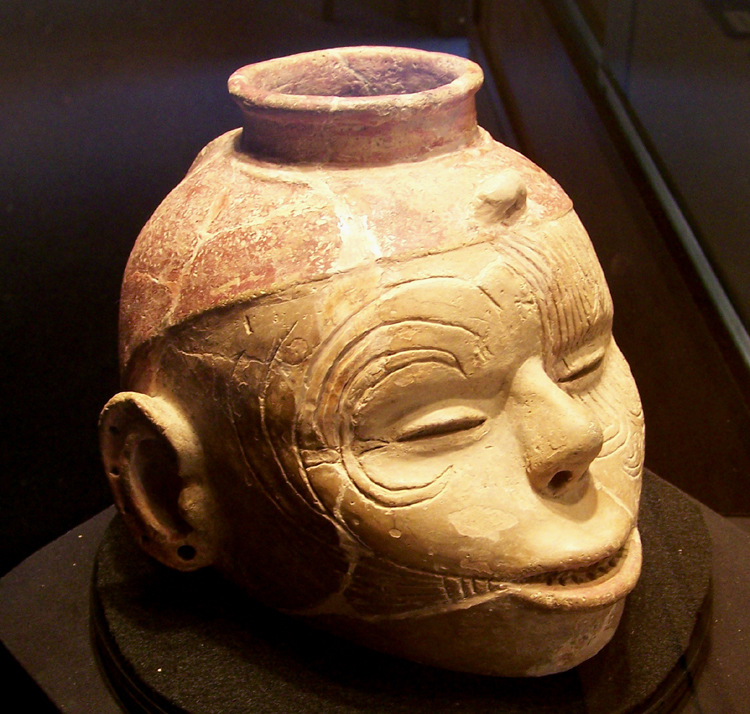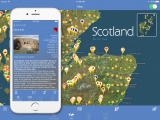<< Other Photo Pages >> Nodena Site - Ancient Village or Settlement in United States in The South
Submitted by AKFisher on Thursday, 07 September 2023 Page Views: 219
Pre-ColumbianSite Name: Nodena SiteCountry: United States
NOTE: This site is 6.201 km away from the location you searched for.
Region: The South Type: Ancient Village or Settlement
Nearest Town: Wilson, AR
Latitude: 35.603290N Longitude: 89.97934W
Condition:
| 5 | Perfect |
| 4 | Almost Perfect |
| 3 | Reasonable but with some damage |
| 2 | Ruined but still recognisable as an ancient site |
| 1 | Pretty much destroyed, possibly visible as crop marks |
| 0 | No data. |
| -1 | Completely destroyed |
| 5 | Superb |
| 4 | Good |
| 3 | Ordinary |
| 2 | Not Good |
| 1 | Awful |
| 0 | No data. |
| 5 | Can be driven to, probably with disabled access |
| 4 | Short walk on a footpath |
| 3 | Requiring a bit more of a walk |
| 2 | A long walk |
| 1 | In the middle of nowhere, a nightmare to find |
| 0 | No data. |
| 5 | co-ordinates taken by GPS or official recorded co-ordinates |
| 4 | co-ordinates scaled from a detailed map |
| 3 | co-ordinates scaled from a bad map |
| 2 | co-ordinates of the nearest village |
| 1 | co-ordinates of the nearest town |
| 0 | no data |
Internal Links:
External Links:

Artifacts from this site are on display in the Hampson Museum State Park in Wilson, Arkansas.[3][4] The Nodena site is the type site for the Nodena phase, believed by many archaeologists to be the province of Pacaha visited by Spanish explorer Hernando de Soto in 1542.
In 1900, a prehistoric mastodon skeleton was discovered 2 miles (3.2 km) south of the Nodena site.[5] In 1964, the Nodena site was declared a National Historic Landmark[2] and in 1966 it was added to the National Register of Historic Places.[1]
Culture of the Nodena people:
Nodena is the type site for an important Late Mississippian cultural component, the Nodena phase, which dates from about 1400–1700 CE. The Nodena phase was a collection of villages (see Eaker site) along the Mississippi River between the Missouri Bootheel and Wapanocca Lake. This culture is contemporary with the Menard complex, Tipton phase, Walls phase and the Parkin phase. The Parkin Indian Mound, the type site for the Parkin phase, is the site of another Late Mississippian village located in Parkin, Arkansas, about 30 miles (50 km) southwest of Wilson. In the early 1540s, the Spanish Hernando de Soto Expedition is believed to have visited several sites in the Nodena phase, which is usually identified as the Province of Pacaha.[6] The Parkin site is a candidate for the province of Casqui.[7][8] Nodena people were part of the Southeastern Ceremonial Complex, an extensive religious and trade network that brought chert, whelk shells, and other exotic goods to the site.
The site had three to eight mounds, two of them large substructure mounds. The largest, designated as "Mound A", was 111 feet (34 m) wide by 120 feet (37 m) long, and 15.5 feet (5 m) high. It had two levels, with the top being 40 feet (12 m) by 60 feet (18 m), and the terrace level being 30 feet (9 m) wide. The remains of three structures were found on the mound, one on the top level and two on the terrace level. The mound designated as "Mound B" was 117 feet (36 m) by 111 feet (34 m) by 4 feet (1.2 m) tall. It had the remains of a 60 feet (18 m) diameter round structure found at its summit. The site also had several large plaza areas, and what Dr. Hampson described as a "chunkey field", which was located directly behind Mound A. A circular mound, designated as "Mound C", was located at the other end of the chunkey field. It was roughly 93 feet (28 m) in diameter and 3 feet (0.9 m) high. A large number of male graves, 314 of 316, were found buried under it.
The houses in the village were laid out in a very orderly fashion, located on the same axis as the mounds at the site, demonstrating that the whole site was planned.[6] Members of the de Soto Entrada described the villages of the Pacaha and Nodena peoples as being the most carefully planned and organized of all the villages they had seen in "La Florida", which was what they called the entire southeast.[7] The villages of this area were described as having few if any trees, probably because this was the primary source of fuel and building materials. Many trees close to the villages would have been cut down for these purposes. Homes were built from wattle and daub, with thatched roofs. The palisade which surrounded the site was designed for defensive purposes. It had bastions at regular intervals, with archer slots to defend against enemy attacks. The peoples of Casqui and Pacaha were in a state of perpetual war with one another, and most large sites throughout the area in this time period had this type of defensive palisade.
The de Soto chroniclers indicate that political provinces characterized by a paramount chief living in a paramount town with satellite vassal towns surrounding it were the major political institutions of this area. The Nodena site was either the main town or one of the larger satellite towns of the Pacaha province.
Pottery:
Most pottery found at the Nodena site is of the kind known as Mississippian Bell Plain. It was buff colored, contains large fragments of ground mussel shell as a tempering agent, and isn't as smooth and polished as other varieties. Other kinds found there are much finer, with a finer ground shell as a temper, some instances being so finely ground as to look untempered. The Nodena phase people put a bowl and a bottle into a grave with the bodies, usually of the finer variety of pottery. Shapes and decoration were varied in the mortuary pottery, from brightly colored abstract spiral designs, to elaborate effigy vessels depicting human heads, animals, and hunters and their prey. Pottery made by the Nodena people was built up from strips of clay, and then smoothed out by the potter, much like other pottery in the Eastern America area where the potters wheel was unknown. Slips using galena for white, hematite for red, and sometimes graphite for black were used to paint the pottery, with a red on white swastika design being particularly popular. Sometimes incising was used, although it is rare in Nodena pottery.[6]
Head deformation:
The people of the Nodena phase practiced artificial cranial deformation or head flattening. Shortly after infants were born, they were strapped to a special carrier which deformed their skulls as they grew. Many of the skeletal remains found at the Nodena site had deformed skulls, of the type defined as fronto-occipital deformation, flattening of the forehead and the back of the head. Of 123 skulls found by Dr. Hampson, only six could be considered "normal", meaning they did not show the signs of head deformation. The functioning of the brain is not affected by cranial deformation, but the overall shape of the skull bones are.[6] This practice was performed by many Native American tribes into historic times, including the Choctaw, although it later fell out of favor.
Agriculture and food:
The people of Nodena were intensely involved in maize agriculture, as well as other food crops originating in the Americas, such as beans, squash, sunflowers and gourds. They also gathered wild foodstuffs such as pecans and persimmons. The de Soto chroniclers described the area as being under heavy cultivation, and the most populous they had seen in La Florida. The Spaniards described groves of wild fruit and nut bearing trees, implying that the Nodena must have left them standing when clearing other trees for the cultivation of maize.[7] The hunting of whitetail deer, squirrel, rabbit, turkey, and mallard was practiced as well as fishing for alligator gar, catfish, drum, and mussels.[6]
Language:
The peoples of Nodena were probably Tunican or Siouan speaking. It is known that the Tunica were in the area at the time of the de Soto Entrada, and the related group of phases present in the region may have all been Tunican speakers, with Caddoan speakers to their west and south. But by the time of later European contact in the 1670s and the beginning of the historic period, the area was occupied by the Dhegiha Siouan speaking Quapaw. Attempts have been made to connect pottery styles and words from the de Soto narratives with historic tribes, but have so far been unsuccessful.[9]
Dr. James K. Hampson:
The museum for the Nodena site is named after Dr. James K. Hampson (1877–1956), owner of the Hampson Plantation on which the Nodena site is located, and the first archaeologist to excavate and preserve the artifacts from the Nodena site and to document their recovery.[4][10] The Hampson Museum State Park in Wilson, Arkansas exhibits an archeological collection of early American aboriginal artifacts from the Nodena site. Cultivation of crops, hunting, social life, religion and politics of that ancient civilization are topics of the exhibition.[3][4] Stone and shell artifacts as well as pottery are on display to illustrate the culture of the Nodena people.
Prehistoric Mastodon skeleton:
Mastodons are members of the prehistoric, extinct genus Mammut, they resemble modern elephants. Native to North America they are said to have lived on the North American continent from almost 4 million years ago until their eventual disappearance about 10,000 years ago.[11] In 1900, archaeologist Dr. James K. Hampson documented the find of skeletal remains of a mastodon on Island No. 35 of the Mississippi River, 2 miles (3.2 km) south of the Nodena site and 23 miles (37 km) south of Blytheville, Arkansas. In 1957 the site was reported as destroyed.[5]. Source: Wikipedia (see below link).
References:
1. National Register Information System. National Register of Historic Places. National Park Service. July 9, 2010.
2. Nodena site. National Historic Landmark summary listing. National Park Service. Archived from the original on March 1, 2007. Retrieved February 21, 2009.
3. The Virtual Hampson Museum. Center for Advanced Spatial Technologies. University of Arkansas, Fayetteville, Arkansas. Retrieved February 21, 2009.
4. Hampson Archeological Museum State Park. Archeological Collection of Nodena Artifacts. Arkansas Department of Parks and Tourism, Division of State Parks. Retrieved February 21, 2009.
5. Williams, Steven (April 1957). "The Island 35 Mastodon: Its Bearing on the Age of Archaic Cultures in the East". American Antiquity. 22 (4): 359–372. doi:10.2307/276134. JSTOR 276134.
6. Morse, Dan (1973). Nodena-An account of 90 years of archaeological investigation in southeast Mississippi County, Arkansas. Arkansas Archaeological Survey Research Series. ISBN 1-56349-057-9.
7. Hudson, Charles M. (1997). Knights of Spain, Warriors of the Sun. University of Georgia Press.
8. Morse, Phyllis (1981). Parkin: the 1978-1979 archeological investigations of a Cross County, Arkansas, site. Arkansas Archaeological Survey. OCLC 7540091. Unknown ID 0882-4591.
9. Michael P. Hoffman (1990). "The Terminal Mississippian Period in the Arkansas River Valley and Quapaw Ethnogenesis". In David H. Dye and Cheryl Ann Cox (ed.). Towns and Temples Along the Mississippi. University of Alabama Press. ISBN 0-8173-0455-X.
10. Williams, Steven (April 1957). "James Kelly Hampson. 1877-1956". American Antiquity. 22 (4): 398–400. doi:10.1017/S0002731600011471.
11. Greek mastodon find 'spectacular'. BBC News. July 24, 2007. Retrieved October 7, 2007.
Further reading and information:
Wikipedia
Virtual Hampson Museum
Directions: From Wilson, AR via US-61 N, 6 mi.
You may be viewing yesterday's version of this page. To see the most up to date information please register for a free account.




Do not use the above information on other web sites or publications without permission of the contributor.
Nearby Images from Flickr

The above images may not be of the site on this page, but were taken nearby. They are loaded from Flickr so please click on them for image credits.
Click here to see more info for this site
Nearby sites
Click here to view sites on an interactive map of the areaKey: Red: member's photo, Blue: 3rd party photo, Yellow: other image, Green: no photo - please go there and take one, Grey: site destroyed
Download sites to:
KML (Google Earth)
GPX (GPS waypoints)
CSV (Garmin/Navman)
CSV (Excel)
To unlock full downloads you need to sign up as a Contributory Member. Otherwise downloads are limited to 50 sites.
Turn off the page maps and other distractions
Nearby sites listing. In the following links * = Image available
6.6km WSW 236° Hampson* Museum
36.9km N 7° Chickasawba Mound* Artificial Mound
51.3km SW 235° Richard's Bridge* Ancient Village or Settlement
54.1km S 189° Chickasaw Heritage Park* Artificial Mound
55.8km SW 233° Berry Cemetery Mound* Artificial Mound
61.7km SSW 193° Chucalissa Prehistoric Indian Village* Museum
63.7km SW 235° Parkin* Ancient Village or Settlement
71.2km SSW 198° Edgefield Mounds* Artificial Mound
72.9km SSW 194° Cheatham Mound* Artificial Mound
94.7km SSW 203° Commerce Mounds* Artificial Mound
98.6km SSW 201° Hollywood Mounds* Artificial Mound
102.2km SSW 200° Johnson Cemetery Mound* Artificial Mound
113.3km NNE 18° Lilbourn Mound Ancient Village or Settlement
113.7km SSW 199° Evansville Mounds* Artificial Mound
114.8km SSW 199° Beaverdam Mounds* Artificial Mound
116.9km E 95° Pinson Mounds - Ozier Mound* Artificial Mound
116.9km E 95° Pinson Mounds - Twin Mounds* Artificial Mound
117.9km E 95° Pinson Mounds* Artificial Mound
117.9km E 95° Pinson Mounds - Sauls Mound* Artificial Mound
118.7km E 95° Pinson Mounds - Mound 28* Artificial Mound
118.9km E 95° Pinson Mounds - Eastern Citadel* Misc. Earthwork
119.0km E 95° Pinson Mounds - Mound 30* Artificial Mound
125.9km SSW 201° West Mounds* Artificial Mound
128.7km NNE 33° Adams Site* Artificial Mound
137.7km SSW 199° Barbee Mound* Artificial Mound
View more nearby sites and additional images






 We would like to know more about this location. Please feel free to add a brief description and any relevant information in your own language.
We would like to know more about this location. Please feel free to add a brief description and any relevant information in your own language. Wir möchten mehr über diese Stätte erfahren. Bitte zögern Sie nicht, eine kurze Beschreibung und relevante Informationen in Deutsch hinzuzufügen.
Wir möchten mehr über diese Stätte erfahren. Bitte zögern Sie nicht, eine kurze Beschreibung und relevante Informationen in Deutsch hinzuzufügen. Nous aimerions en savoir encore un peu sur les lieux. S'il vous plaît n'hesitez pas à ajouter une courte description et tous les renseignements pertinents dans votre propre langue.
Nous aimerions en savoir encore un peu sur les lieux. S'il vous plaît n'hesitez pas à ajouter une courte description et tous les renseignements pertinents dans votre propre langue. Quisieramos informarnos un poco más de las lugares. No dude en añadir una breve descripción y otros datos relevantes en su propio idioma.
Quisieramos informarnos un poco más de las lugares. No dude en añadir una breve descripción y otros datos relevantes en su propio idioma.